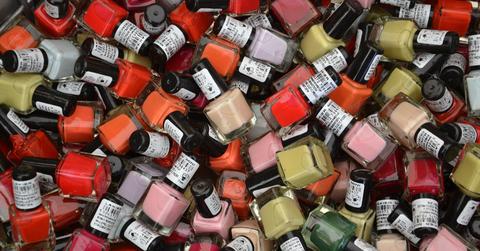The Truth Behind The Toxins In Your Nail Polish
We think of manicures and pedicures as the ultimate in pampering. But the nail polishes we put on our bodies may also be leaching toxins into our systems that can cause serious health problems. Here are the biggest offenders.
Updated May 23 2019, 11:38 a.m. ET
We all know harmful toxins can enter our bodies through the food we eat and the chemicals our skin comes in contact with. Still, we rarely connect those threats with our fingernails and toenails. In my opinion, we should.
The concerning truth is that your nails work the same way, potentially absorbing toxins in nail polish and offering a direct line to your blood stream. A study led by Duke University the Environmental Working Group (EWG) found that every time we get our nails done, at least one potentially hormone-disrupting chemical makes its way into our bodies.
The Food and Drug Administration is charged with regulating nail polishes, but only post-market. That means companies in violation of regulations can be charged, but not before products hit shelves. You’re right if you’re thinking human nails aren’t terribly absorbent—but nail solvents, as well as some polishes themselves, can wear down your nails, thereby making them permeable and allowing toxins to get into your body.
Here are the most common ingredients in nail polish that could be leaching into that bodily temple of yours.
Camphor
Camphor is a traditional folk remedy made from distilled bark and wood of camphor trees to heal everything from hemorrhoids to warts. Today camphor is chemically derived from turpentine oil for use in products such as Vicks VapoRub to aid with cough suppression.
Camphor is also used as an ingredient in nail polish to create a glossy sheen, in spite of the fact that it’s been shown in tests to cause skin irritations, as well as nausea, headaches and liver dysfunction when inhaled.
DBP (dibutyl phthalate)
The EWB ranks DBP at its highest possible danger level. The chemical is a known endocrine disruptor and already banned in Europe after tests showed DBP’s potential for causing reproductive problems. I don’t know about you, but to me, impaired hormonal development and organ damage seem like high prices to pay for chip-free nail polish.
Formaldehyde
That’s right—the same stuff used to embalm dead bodies is used to harden nail polishes and prevent bacterial growth. Granted, formaldehyde is also naturally produced by our bodies (albeit in very low amounts), but I digress.
When formaldehyde is exposes to us in larger doses (say, at the levels salon workers breathe in, or when you get your nails done regularly—or exposure through skin and nail absorption), you may run into a lot of health problems like asthma, abnormal fetal development, convulsions, nausea and even miscarriages. A byproduct of formaldehyde is formaldehyde resin, which also shows up in nail polishes and can cause adverse skin reactions and reduced nerve sensation.
Toulene
Toulene is present in nail polishes and nail-polish removers. You can recognize it by its sweet, but highly toxic smell; which has been shown to decrease brain function, mess with neurological systems, and cause hearing loss and nausea. All that, to make your nail polish go on nice and smooth.
California includes toluene in its Prop 65 list of harmful chemicals, and the European Union has outlawed the chemical’s presence in personal care products.
Triphenyl phosphate (TPHP)
This toxic heavyweight appeared in the bodies of every single woman who painted her nails for the Duke University/ EWG study.
TPHP is another endocrine-disrupting chemical also used in plastics manufacturing and as a fire retardant in foam furniture.
TPHP appeared in a whopping 49 percent of 3,000 nail products compiled in EWG’s Skin Deep database. Oh—and some polishes containing the chemical don’t disclose it on their packaging.
Don’t worry—there are alternatives!
The fact that a lot of mainstream polish is riddled with toxins doesn’t mean you can’t still enjoy glossy nails or treat yourself to manicures and pedicures. There are an increasing number of salons offering eco-friendly, toxin-free nail polishes, and beauty supply stores often stock eco-friendly, body-friendly options.
At the very least, be sure the brands of nail polish you use steer clear of DBP, formaldehyde and TPHP. That protects you, and the salon worker who’s been hired to pamper you. Here are some great options for polishes that won’t cost you your health.
